The Future Is Now
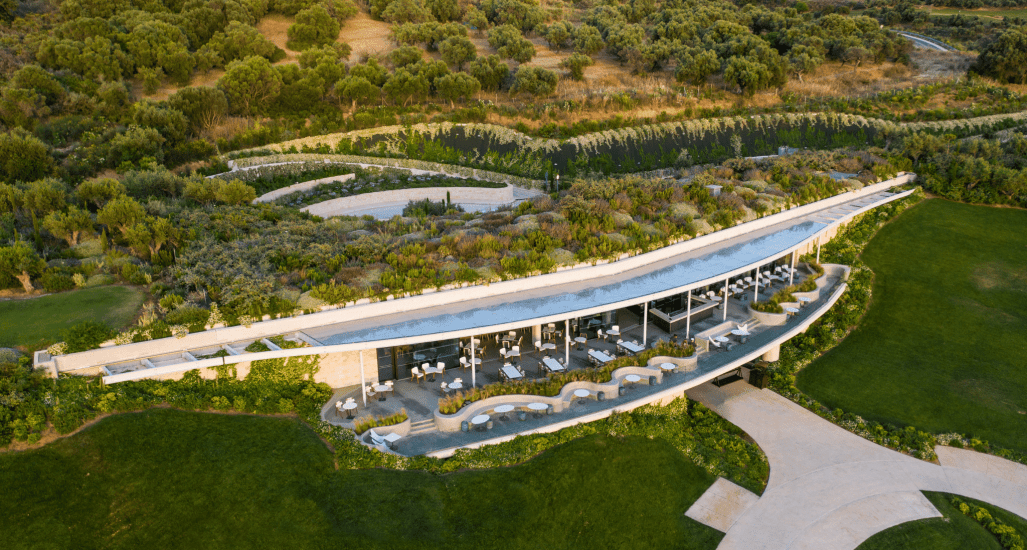
SUSTAINABILITY. There’s a word you’ve probably heard more and more lately when it comes to golf courses. But what does it mean, exactly?
“I’ve noticed sustainability gets used frequently as a synonym for ‘environmental efforts,’” said Brianne Kenny, Manager of Environmental Science at Troon. “While those are important aspects, they are just one of the three traditional pillars of the sustainability concept. The other two pillars are social and economic. It’s important to remember these three together.
Kenny knows there is already a demand for sustainable practices from golfers, the golf industry, and especially from the public. “Beyond demand though, the point of sustainability is to find ways to keep good environmental, social, and financial health.”
After three years in her job, Kenny has been pleasantly surprised to find out how much people throughout the world of Troon genuinely care about the impact they have on their surroundings, both professionally and personally. “I’ve encountered many members, managers, and employees who are engaged and looking for ways to improve,” she said. “We still have a lot of work to do, but having the caring, awareness, and curiosity from people across the company is how we keep moving forward.”
Here’s a small sampling of programs across the Troon portfolio that are having an important sustainability impact on and off the course.
COSTA NAVARINO —Greece
Pictures often say more than words, and one look at The Bay Clubhouse at Costa Navarino makes quite a statement. It not only looks cool; it helps cool itself. The design of The Bay Clubhouse, which opened in 2019, covers more than 2,000 square meters and is based on the principles of bioclimatic architecture. It features a total of 27,500 plants and trees, both around the clubhouse and on its rooftop, that create a unique microclimate which contributes to the optimization of air quality and cooling of the building. In addition, the use of latest technology materials and monitoring systems maximizes the building’s energy efficiency.
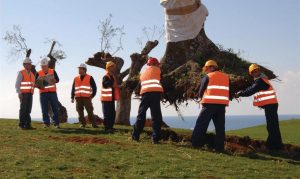 Across the destination’s distinct resort areas, the largest olive tree transplantation program ever conducted in Europe continues. Characteristic of Greece’s Messinia region, where Costa Navarino is located, the olive trees were moved during the resort’s construction. Most of the ones replanted so far (6,800), are located at Navarino Dunes and Navarino Bay (home to The Dunes Course and The Bay Course respectively). Some additional olive trees were replanted at Navarino Hills (home to two new courses overlooking the Bay of Navarino and designed by two-time Masters champion José María Olazábal), along with approximately 52,000 indigenous forest plants, shrubs, and seasonal local flowers and herbs. Upon completion of all areas at Costa Navarino, at least 16,000 olive trees will be replanted.
Across the destination’s distinct resort areas, the largest olive tree transplantation program ever conducted in Europe continues. Characteristic of Greece’s Messinia region, where Costa Navarino is located, the olive trees were moved during the resort’s construction. Most of the ones replanted so far (6,800), are located at Navarino Dunes and Navarino Bay (home to The Dunes Course and The Bay Course respectively). Some additional olive trees were replanted at Navarino Hills (home to two new courses overlooking the Bay of Navarino and designed by two-time Masters champion José María Olazábal), along with approximately 52,000 indigenous forest plants, shrubs, and seasonal local flowers and herbs. Upon completion of all areas at Costa Navarino, at least 16,000 olive trees will be replanted.
COSTA NAVARINO IS IN THE MIDST OF THE LARGEST OLIVE TREE TRANSPLANTATION PROGRAM EVER CONDUCTED IN EUROPE.
TEMES S.A., developers of Costa Navarino, believe in commitment to economic, environmental, and social responsibility, aiming at sustainable tourism development in harmony with the natural environment and local communities of Messinia. In fact, sustainability is embedded in the development concept of Costa Navarino, as a guiding principle that determines the developer’s actions from the planning phase through to the construction and operation. TEMES sees sustainability as an effort to provide the next generation with the means and the capabilities to create a better future for the planet.
THE GROVE —England
The tee box on the par 4 fifth hole at The Grove looks like any of the other well manicured tee boxes at the Kyle Phillips-designed course located 18 miles northwest of central London. Until you notice the solar panel just to the right of it. That’s what powers a new hydroponic system that irrigates the tee area from the root zone upwards with more efficiency. It’s the first of its kind in Europe and just one of the reasons why The Grove was named “Environmental Golf Course of the Year” at the Golf Environment Awards 2022.
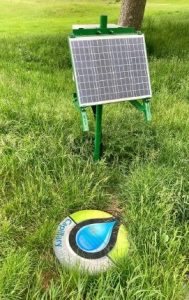 “This award, which underlines a huge team effort at The Grove, recognizes how we continue to successfully introduce environmentally sustainable management projects across and around our 18-hole golf course, and throughout the gardens and wider estate,” said Phillip Chiverton, Golf Course and Estate Manager. “These projects are achieving an increase in habitat varieties, significantly improving playing experiences for our daily fee guests, and providing a positive contribution to wildlife across the wider estate.”
“This award, which underlines a huge team effort at The Grove, recognizes how we continue to successfully introduce environmentally sustainable management projects across and around our 18-hole golf course, and throughout the gardens and wider estate,” said Phillip Chiverton, Golf Course and Estate Manager. “These projects are achieving an increase in habitat varieties, significantly improving playing experiences for our daily fee guests, and providing a positive contribution to wildlife across the wider estate.”
Recently awarded GEO Certified® status (which confirms the course has met a credible standard in the areas of nature, resources, climate, and community, and is committed to continual improvement), The Grove has implemented an array of efforts across its 300 acres. These include a rainfall compensation system that creates annual water savings of up to 30 percent; computer monitoring of soil moisture levels to accurately deliver water by volume and location; minimizing areas of managed turf to reduce mowing, irrigation, and use of chemicals; and collaborating with the Hertfordshire & Middlesex Wildlife Trust to create areas of naturalized habitat. There is also an ongoing investment in renewable energy programs and active management of woodlands, creating new habitats for wildlife and replanting where appropriate.
“We are very proud to receive GEO Certification and thank Phillip Chiverton and Sam Reid (head greenskeeper) for leading this vitally important work,” said Director of Golf Brad Gould.
“While additional irrigation heads seems like more water would be used, the opposite is actually true,” said Stevens. “More heads allow us the chance to put water exactly where it’s needed and minimizes the need to potentially ‘overwater’ unnecessary areas just to provide enough water to one location. During each improvement to a golf course, careful consideration should be given to the irrigation design to ensure the most uniform coverage possible.”

BALLENISLES COUNTRY CLUB —Florida
You’ve heard of island greens, right? How about a Bird Island? That can be found in the middle of a pond on the East Course at this club in Palm Beach Gardens. It serves as a breeding ground for a colony of White Wood Stork, North America’s only native stork, whose nesting sites are slowly diminishing due to urban development.
“Having an established rookery on site allows us the opportunity and responsibility to help protect and grow one of nature’s beautiful species,” said Director of Agronomy Michael Stevens. “Bird Island provides nesting birds and vulnerable chicks protection and availability to food sources during critical times and their annual cycles. It’s with this understanding that we continue to focus on the future of Bird Island and its native residents.”
BallenIsles is also in a constant state of water usage monitoring and adjusting based on daily field and environmental observations, according to Stevens. The center of the irrigation output is based around Evapotranspiration (ET), with the primary goal being to recharge the rootzone’s moisture needs after daily loss due to plant uptake and what’s evaporated throughout the day. “We have seen that moving away from a baseline of ‘default run-times’ across the board and embracing the plant’s true needs as related to ET provides the most efficient use of watering practices leading to conservation long term,” he said.
Additional attention is given to “micro-climates” on the property where varying soil types and shaded environments create varying watering needs. In these areas, specific inputs and adjustments such as hand watering, wetting agents, nozzle swaps, subsurface drainage, soil modification/organic introduction, and additional irrigation heads play a key role in ensuring the most efficient and highest levels of conservation are achieved.

RESERVA CONCHAL GOLF CLUB —Costa Rica
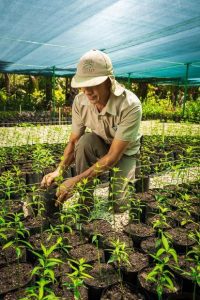 Despite working at a location that overlooks the vast Pacific Ocean on the west coast of Costa Rica, the team at Reserva Conchal Golf Club knows how valuable water is to the Robert Trent Jones Jr.-designed course, the resort, and the local community. That’s why it has four desalination units that convert salt water from the sea into water suitable for human, industrial, and irrigation consumption, plus two aerobic wastewater treatment plants. Water processed through the latter is used again to irrigate the golf course, where the main species of trees are protected and pruned to ensure a lengthy lifespan.
Despite working at a location that overlooks the vast Pacific Ocean on the west coast of Costa Rica, the team at Reserva Conchal Golf Club knows how valuable water is to the Robert Trent Jones Jr.-designed course, the resort, and the local community. That’s why it has four desalination units that convert salt water from the sea into water suitable for human, industrial, and irrigation consumption, plus two aerobic wastewater treatment plants. Water processed through the latter is used again to irrigate the golf course, where the main species of trees are protected and pruned to ensure a lengthy lifespan.
That’s just part of what has made the course a Certified Audubon Cooperative Sanctuary since 2002, one of just three courses in Costa Rica to earn that recognition. “Reserva Conchal Golf Club has shown a strong commitment to its environmental program. They are to be commended for their efforts to provide a sanctuary for wildlife on the golf course property,” said Christine Kane, CEO at Audubon International.
“As a Costa Rican, I feel proud and can confirm that the vision of leaving the world better for future generations is real and is part of the culture that these projects seek to permeate in its associates, the communities, and those who visit us,” said Sergio Jose Chaves Ramirez, golf course superintendent. “This is a differentiating aspect that distinguishes us.”
AT RESERVA CONCHAL, PROCESSED WATER IS REUSED TO IRRIGATE THE RESORT AND GOLF COURSE.
Elsewhere at the resort, biological corridors are promoted so that species can move from an on-site Wildlife Refuge founded in 2009 to a Brasilito Mangrove area. Fruit trees and forest trees germinate at the resort’s orchard where trees in danger of extinction, such as rum rum, mahogany, and real guayacan, are also grown. The latter are used for reforestation campaigns coordinated by the Reserve (which resort guests and homeowners can participate in) as well as for donations to schools, development associations, and other groups. A garden project also employs local women who receive training in crop management, planting, irrigation, fertilization systems, and post-harvest techniques. That work produces varieties of healthy and chemical-free vegetables for guests of The Westin Reserva Conchal and W Costa Rica Reserva Conchal hotels.
NATIONAL LINKS TRUST —Washington D.C.
One of the first tasks the National Links Trust (NLT) took on with Troon after winning the contract to manage three Washington D.C.–area courses in 2020 was to remove an unwanted guest: invasive vegetation around Kingman Lake and along the Anacostia River at Langston Golf Course.
“We estimate about 35 acres of that vegetation will be removed during a multi-step process,” said Andrew Szunyog, Project Manager, Sustainability and Community Engagement, NLT. “Working with our community partner, the Anacostia Watershed Society (AWS), we have hired tree removal crews and hold volunteer events to take down that material, which then goes through an industrial woodchipper and gets returned right back to where it was. Doing that helps prevent potential erosion after rain, and that mulch will also cover and prevent daylight from getting to any invasive material still in the ground.”
The work is also bringing back wildlife, including beavers and otters, at Kingman Lake, and improving biodiversity with the return of birds and pollinators. The revitalized areas also get covered by native grasses to help restore wetland habitats by creating a natural filtration barrier to help clean storm water runoff.
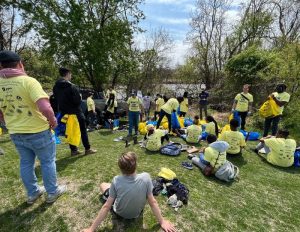 “It also opens up sight corridors on the golf course and allows air to move which helps keep grass healthier and cooler during the hot summer months,” said Szunyog. “In some places, the invasive vegetation was creeping 20-30 yards into playable areas on the course and covering up rough line contours on several holes.”
“It also opens up sight corridors on the golf course and allows air to move which helps keep grass healthier and cooler during the hot summer months,” said Szunyog. “In some places, the invasive vegetation was creeping 20-30 yards into playable areas on the course and covering up rough line contours on several holes.”
The beneficiaries of the ongoing work are not just golfers, but also birdwatchers, kayakers who use the Potomac and Ana-costia Rivers, and the housing communities around the courses.
“The way I view our work is, how can we make golf serve the community beyond just generating revenue from rounds of golf?” said Szunyog. “How do we create economic and ecological value? And how can the projects support the overall climate action plan that Washington D.C. has established? That can also include looking into renewable energy, increasing biodiversity, and having workforce development programs including internships to get underrepresented populations either playing golf or viewing it as a career outlet. But we’ve really just started.”
PRINCEVILLE MAKAI GOLF CLUB —Kauai
“ALOHA” can mean hello or goodbye, but at this golf course on the North Shore of Kauai, it means saying so long to single-use plastic water bottles. That effort, begun three years ago, is designed to help reduce plastic pollution in oceans, fight the negative impacts of plastic pollution on wildlife, and to cut landfill inputs. Guests can bring their own aluminum vessel products or use complimentary paper cups at two FloWater refilling stations for their hydration needs.
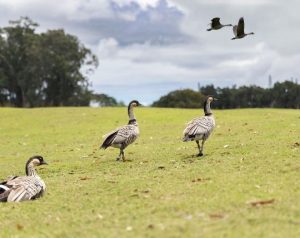 “The stations give an indicator reading of how many water bottles were saved from entering landfills for the life of the unit,” said Aaron Rego, Director of Sales and Marketing. “I recently checked those and to date the units have saved 798,000 water bottles from entering landfills. That’s a lot of single use plastic!”
“The stations give an indicator reading of how many water bottles were saved from entering landfills for the life of the unit,” said Aaron Rego, Director of Sales and Marketing. “I recently checked those and to date the units have saved 798,000 water bottles from entering landfills. That’s a lot of single use plastic!”
The conservation efforts here also extend to the wildlife that call the course home, a population that includes five protected and endangered species of birds. “Local U.S. Fish and Wildlife experts regularly work with our staff by surveying and supporting the needs of the Nene Goose, which is the state bird of Hawaii,” said Rego. “The most recent survey confirmed Princeville Makai Golf Club is now home to over 25 percent of the entire Nene population found on earth.”

